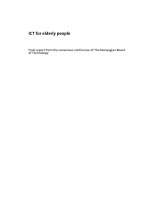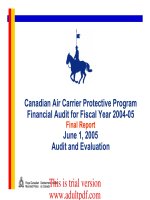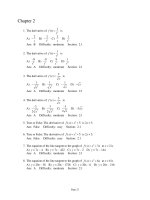final report applied calculus for it course
Bạn đang xem bản rút gọn của tài liệu. Xem và tải ngay bản đầy đủ của tài liệu tại đây (1.39 MB, 21 trang )
<span class="text_page_counter">Trang 1</span><div class="page_container" data-page="1">
<b>FACULTY OF INFORMATION TECHNOLOGY</b>
<b>NGUYỄN VIỆT GIA TRỰC – 523H0109TRẦN VĂN HUY – 523H0035</b>
</div><span class="text_page_counter">Trang 2</span><div class="page_container" data-page="2"><b>TON DUC THANG UNIVERSITYFACULTY OF INFORMATION TECHNOLOGY</b>
<b>NGUYỄN VIỆT GIA TRỰC – 523H0109TRẦN VĂN HUY – 523H0035</b>
<b>FINAL REPORT</b>
<b>APPLIED CALCULUS FOR ITCOURSE</b>
<b>InstructorM.A. Phạm Kim Thủy</b>
<b>Ho Chi Minh City, 2024</b>
</div><span class="text_page_counter">Trang 3</span><div class="page_container" data-page="3">Firstly, we would like to express our gratitude to Ton Duc Thang University for providing us with a rich and meaningful educational experience. The university is an environment that not only enchanes our knowledge but also helps us develop ourselves.
Next,we want to express our gratitude to the Faculty of Information Technology for their relentless commitment to quality. The dedication of teaching staff in impartingknowledge, encouraging thinking, and always all our questions in approching the subject has been remarkable.
Finally, we would like to thank our instructor Pham Kim Thuy, who has continuously shared her professional knowledge and passion with us. The enthusiastic support of M.A. Pham Kim Thuy has had a significant impact on our learning journey.
--- 7 January, 2024
</div><span class="text_page_counter">Trang 4</span><div class="page_container" data-page="4">Using several mathematics theories like functions, derivates, applications ofderivatives, simple integration and simple multivariable calculus, etc… to solve the questions and explain it in an intuitive way in order to help the readers tounderstand both the questions and how we solve them.
</div><span class="text_page_counter">Trang 5</span><div class="page_container" data-page="5"><b>CHAPTER 1. INTRODUCTION...1</b>
1.1 Objective of the report...1
<b>CHAPTER 2. THEORETICAL BASIS...1</b>
2.1 Functions, Limits and Continuity...1
</div><span class="text_page_counter">Trang 7</span><div class="page_container" data-page="7"><b>CHAPTER 1. INTRODUCTION</b>
<b>1.1 Objective of the report</b>Using theories in applied calculus to solve the problems. Explain it in a way that help the readers to understand every single steps in solving the problems. Increase the capability in solving problem, which occurrs in coding and programming.
<b>CHAPTER 2. THEORETICAL BASIS</b>
<b>2.1 Functions, Limits and Continuity</b>2.1.1 Functions
Let X and Y be two sets:Let f : X→Ybe a functiono Xis domain of f;
o Y is codomain of f
Unless otherwise stated, X and Y are always taken to be subsets of the set of real numbers ℝ
We make the following convetion:
o If X is not stated, the domain of f is taken to be the largest possible set(∈ ) on which ℝ f is defined
o If Y is not stated, take Y =R
The range is the set of images:
</div><span class="text_page_counter">Trang 8</span><div class="page_container" data-page="8">(but not equal) to a, then we write
x→a=¿f (x)→L2.1.3 One-Side Limits
The right – hand limit:
If as x is close to a from the right f (x) is close to L, or simply
The left – hand limit:
If as xclose to afrom the left f (x) is close to L, or
o fis differentiable at a if f<small>'</small>(a) existso f '(a) is the slope of y=f (x ) at x=a
Let x=a+ h then h=x−a⇔ x→a We may use an equivalent definition:f<small>'</small>(<sub>a</sub>)≔ lim
f(x)−f (a)x−a
The tangent line to y=f (x ) at (a, f(a)) is the line passing through (a, f(a))
with slope f '(a):
2.2.2 Derivative as a function
The derivative of f at point x=a :
</div><span class="text_page_counter">Trang 9</span><div class="page_container" data-page="9">f(a+h)−f (a)h
The derivative of f as a function:
f(x+h)−f (x)h
o f<small>'</small>(<sub>x</sub>)<sub>= =</sub><sub>y</sub><small>'</small> dydx<sup>=</sup>
o At least one of f<small>x</small>(a,b) and f<small>y</small>(a,b) does not exists
Therefore if z=f (x , y) at a local extreme value at (a,b) then (a,b) is acritical point of f
<b>2.4 Sequence and Series</b>
2.4.1 Definition
A sequence is a list of numbers written in a definite order:a<small>1</small>,a ,a<small>23</small>,…..a<small>n</small>,……
a<sub>1</sub>: the first term, a<sub>2</sub>: the second term,…..a<sub>n</sub>: the n term<small>th</small>
The sequence is denoted by
{
a<sub>n</sub>}
<b>CHAPTER 3. SOLUTIONS</b>
<b>3.1 Question 1</b>The question requires us to tell which function is odd, even or neither.
</div><span class="text_page_counter">Trang 10</span><div class="page_container" data-page="10">+xf<sup>(</sup>x<sup>)</sup>=x<small>3</small>+xf(x)= <sup>4</sup>
−4f(<sub>x</sub>)= <sup>x</sup><sup>3</sup>
The range of the function is
{
x←√
2x>√
2</div><span class="text_page_counter">Trang 11</span><div class="page_container" data-page="11">o f(−x)= <sup>4</sup>
Comparing (1) to (2) we see that f(x)≠f (−x ) and (2) comparint to (3) is
f(−x)≠−f (x ) so the function 4 is neither even nor odd.
<b>3.2 Question 2</b>
Question 2 requires us to find the following lim <sup>555</sup>x<small>2</small>
−25<sup> as:</sup>x→5<small>+¿¿</small>
<b>3.2.1 Function 1</b>
Replace x with 5<small>+¿ ¿</small> we will have:
lim <sup>555</sup>25<small>+¿−25</small>= <sup>555</sup>
=+∞¿
</div><span class="text_page_counter">Trang 12</span><div class="page_container" data-page="12">Because 555 is a positive numerator and x approches 5 from the postive side,the limit is +∞.
<b>3.2.2 Function 2</b>
Replace x with 5 we will have:<small></small>
As x approches -5 from the negative side, limit of this function +∞
<b>3.3 Question 33.3.1 </b>y=
√
x−4In this function u is
√
x+4 and v is√
x−4. Using derivative of square root wewill have:</div><span class="text_page_counter">Trang 13</span><div class="page_container" data-page="13">y<small>'</small>=(
√
x−4)<sub>'.</sub>(√
x +4)−(√
x−4)<sub>.</sub>(√
x +4)<small>1</small>2
√
x<sup>⋅</sup>(√
x+4)−(√
x−4). <sup>1</sup>2√
x(√
x+4)<small>2</small>4
√
x(√
x+4)<small>2</small>= <sup>4</sup>√
x(√
x +4)<small>2</small><b>3.3.2 </b>y=
(√
x10<sup>−1</sup>)
<small>−10</small>In this function we neeed to use the Chain Rule which can be explained in a simple way like:
Suppose we have y=f(<sub>u</sub>) and u=g (x):
df(u)du <sup>.</sup>
Using the Chain Rule in the function 2, we’ll have:
<small>⟨</small>¿<small>⟩</small>y'=−10
(√
x10<sup>−1</sup>)
<small>−11</small>⋅ 120
√
x2
√
x <sup>=</sup><b>3.4 Question 4</b>
In question 4, it requires us to find the equation of tangent line to the graph
y=1+2 ⅇ<small>x</small> at the point where x<small>0</small>=0.
To find the equation of tangent line we follow these steps:1. Find the derivative of y
2. Evaluate the derivative at x
3. Find the y-coordinate at x
</div><span class="text_page_counter">Trang 14</span><div class="page_container" data-page="14">4. Write the equation of the tangent line with the general form of the equation is y− y<small>1</small>= y'(x<small>0</small>)(x −x<small>1</small>)
Following the steps, we’ll have:Step 1: Derivative of y=1+2 ⅇ<small>x</small> is y<small>'</small>
=2 ⅇ<small>x</small>
Step 2: Replace x=0 in the y' we’ll have y<small>'</small>(x<small>0</small>)=2 e<small>0</small>=2
Step 3: The y-coordinate of the function is the point where the tangent line must pass through on the curve when x=0. So to find the y-coordinate, replace x in the function y=1+2 e<small>x</small>, y<sub>1</sub>=3
Step 4: As we have the general form of the equation, replace all the numberswe found: y− y<small>1</small>= y<small>'</small>
(x<small>0</small>)(x−x<small>0</small>)y− =3 2 (x−0)
The question requires us to:
To find critical numbers of f we need to find derivative of f, which wealready have, then we solve f<small>'</small>(<sub>x</sub>)=0. After solving f '(x) = 0, we will criticalnumbers of f
We need to antiderivative f '(x) in order to find the intervals which f isincreasing or decreasing.
After having all the necessary data, we write a variation table includes f '(x)f (x) and x we already find above, then calculated the local minimum and maximumof f based on variation table.
Solving f<small>'</small>(<sub>x</sub>)=0:
{
sin x+ cosx=0sin x−cosx=0</div><span class="text_page_counter">Trang 15</span><div class="page_container" data-page="15">¿
{
x=<sup>3 π</sup><sub>4</sub> +kπx=<sup>π</sup><sub>4</sub>+kπNow we need to antiderivative f '(x):
∫ (sin x +cos x )(sin x−cos x )d¿∫¿
¿∫ sin x<small>2</small>
dx−∫ cos x<small>2</small>dx
We called I= ∫ sin x<small>2</small>dx
¿∫ sin x<small>2</small>dx¿ ∫¿
¿
(
x −<sup>1</sup>2)
+C<sub>1</sub>We called k =∫ cos x<small>2</small>
¿∫ cos x<small>2</small>
dx¿ ∫¿
¿
(
x +<sup>1</sup>2<sup>sin 2 x</sup>
)
+C<sub>2</sub>We have:
I+ K=<sup>1</sup>2
(
x−<sup>1</sup>2<sup>sin 2 x</sup>
)
−<sup>1</sup>2(
x +<sup>1</sup>0
</div><span class="text_page_counter">Trang 16</span><div class="page_container" data-page="16">As we can see, after passing through π4<sup> and </sup>
3 π
4<sup> the sign of equation </sup>
changes, it means that π4<sup> and </sup>
3 π
4 <sup> is the critical numbers of </sup><sup>f (x)</sup>
We also see that the function decreases in the interval from 0to π4<sup>and </sup>
decrases in the interval from 3 π4 <sup> to </sup><sup>2 π</sup><sup>.</sup>
We see that the function increases in the interval from π4<sup>to </sup>
3 π4 <sup>.</sup>
function f (x). In the variation table we see that local maximum is −1
We place u=<sup>1</sup>
x<sup>dx</sup><sup>. Now we have:</sup>L=
∫
Now, we place t=1+u<small>2</small> and dt=2 udu. Then, we have:
Therefore, the value of (L) is approximately 4,828.
<b>3.7 Question 7</b>
</div><span class="text_page_counter">Trang 17</span><div class="page_container" data-page="17">We’re given a<sub>1</sub>,a<sub>2</sub>,a<sub>3</sub>,…a<sub>n</sub>,… are real numbers with these followingconditions:
a<small>n</small>>0 ,n∈ Z<small>+¿¿</small>
The series a<sub>2</sub>+a a<sub>4</sub>+ <sub>8</sub>+a<sub>16</sub>+…+ a<sub>2</sub><small>n+</small>…<sub> diverges</sub>
We’re required to determine the convergence or divergence of the followingseries. Explain in details:
To determine the convergence of the given sequence. As we already have aseries that already diverges, we use the Comparison Test.
The Comparsion Test can be explained:Let
∑
<small>n =1∞</small>
a<sub>n</sub> and
∑
<small>n =1∞</small>
b<sub>n</sub> be series such that:
0 ≤a ≤b<sub>n</sub> <sub>n</sub> for all n (Or for all n≥ N)
Then
{ ∑
<small>n =1∞</small>
a diverges<small>n</small> ⇒
∑
Beside that we’ll use Stolz – Cèsaro criterion:
Suppose we have b<sub>n</sub> is a sequence of real numbers which strictly increasingor decreasing and unbounded, and (a<small>n</small>) is sequence of real numbers, then the limit ofsequence a<sub>n</sub>
</div><span class="text_page_counter">Trang 18</span><div class="page_container" data-page="18"><small>n=2∞</small> a<small>n</small>
<small>n=2∞</small> a<small>2</small>
Based on the condition that a<sub>n</sub>>0:
Using Comparison Test:We have:
S<small>1</small>=a<small>2</small>+a a<small>4</small>+ <small>8</small>+a<small>16</small>+…+a<sub>2</sub><small>n+…</small> divergesBecause a<sub>n</sub>≥ 0 , ∀ n∈ Z<small>+¿¿</small>
so a<small>n</small>+n also divergesBased on Stolz – Cèsaro criterion we have:
<small>n=2∞</small> a<sub>n</sub>
a<small>n</small>be a seriesSuppose lim
<small>n→∞</small>
|
a<small>n +1</small>a<sub>n</sub>
|
=L, where 0 ≤ L≤∞.o If 0 ≤ L≤1, then∑
<small>n =1∞</small>
a<small>n</small> is convergent.o If 1 ≤L≤ ∞, then
∑
<small>n =1∞</small>
a<sub>n</sub> is divergent.o If L=1, the convergence of
∑
<small>n =1∞</small>
a<small>n</small> is inconclusive.We have:
</div><span class="text_page_counter">Trang 19</span><div class="page_container" data-page="19">The question requires us to find the revenue in case the price of eachearphone is $225.
Here’s how to find the revenue when earphones are sold $255 each:Initial price: $ 55
Price increase per step: $ 5
Decrease in sales per price increase: 20 earphones
Number of price increasees from $55 to $255: ((255−55 5)/ : 40 timesTotal decreases in sales due to price increases: 40 .20=800<sub> earphones</sub>
</div><span class="text_page_counter">Trang 20</span><div class="page_container" data-page="20">Initial earphones sold: 1000 earphones
Number of earphones sold at $255: 1000 800 200− = earphonesRevenue at $255 price: 200 . 255=$51000
The last result is: $ 51000.
<b>CHAPTER 4. Conclusion</b>
This report has delved deeply into the various aspects and applications ofApplied Calculus, highlighting its significance. Through exploration of severalquestions about Calculus, we learned about how Applied Calculus increase abilityof critical thinking and solving problems, which is very vital in our road to becomean developer.
One of the key findings of this report is applying theories into practice. Thisinsight not only enriches our understanding of calculus but also helps us reinforcedour knowledge, increase our ability of solving complex probems, underscoring thepower and versatility of calculus in solving real-world challenges.
In conclusion, our journey through the world of Applied Calculus has beenimmensely enriching. It has not only enchanted our analytical and problem-solvingskills but has also increase our ability of teamworking. As we continue to advancein our academic road, the knowledge and expericenes accquired through this studywill be invaluabe.
</div><span class="text_page_counter">Trang 21</span><div class="page_container" data-page="21">[1]. Maurice D. Weir, Joel Hass, George B. Thomas, [2010], Thomas'calculus, Pearson Education, Boston.
[2]. R. L. Burden, J. D. Faires, [2011], Numerical Analysis, 9th edition,Brooks/Cole, Boston
[3]. James Stewart, [2012], Calculus, Brooks/Cole, Belmont.
[4]. R. W. Hamming, [1986], Numerical methods for scientists andengineers, Dover, New York.
[5]. Steven C. Chapra, [2012], Applied numerical methods with MATLABfor engineers and scientists, McGraw-Hill Education, New York.
[6]. Timothy A. Davis, [2011], MATLAB primer, CRC Press, Boca Raton
</div>
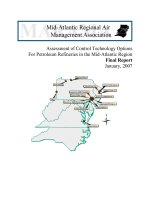
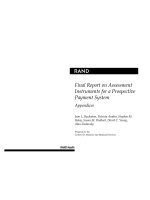
![Study materials for MIT course [22 101] applied nuclear physics](https://media.store123doc.com/images/document/14/rc/jx/medium_DLiOAYd9bs.jpg)
